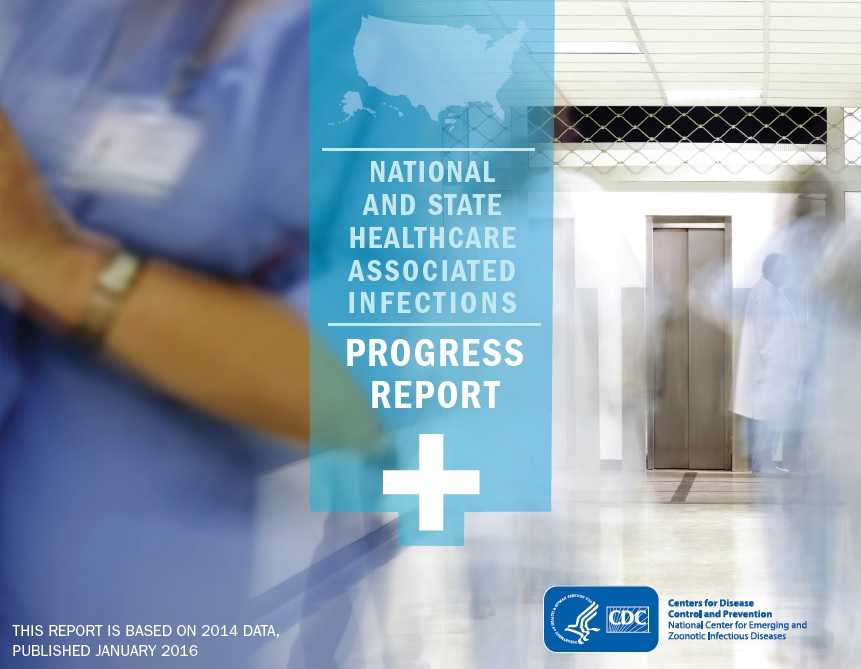Healthcare-associated Infections (HAI) Progress Report
The National and State Healthcare-Associated Infections Progress Report expands upon and provides an update to previous reports detailing progress toward the ultimate goal of eliminating HAIs. The HAI Progress Report consists of national and state-by-state summaries of healthcare-associated infections. Infection data in this report includes central line-associated bloodstream infections (CLABSI), catheter-associated urinary tract infections (CAUTI), select surgical site infections (SSI), hospital-onset Clostridium difficile (C. difficile) infections, and hospital-onset methicillin-resistant Staphylococcus aureus (MRSA) bacteremia (bloodstream infections). Detailed data points can be found in the report’s Data Tables.
The most recent HAI Progress Report includes 2014 data, published in 2016. This report describes significant reductions reported at the national level in 2014 for nearly all infections when compared to the baseline data. CLABSI and abdominal hysterectomy SSI show the greatest reduction. Some progress is shown in reducing hospital-onset MRSA bacteremia and hospital-onset C. difficile infections. The previous two reports showed an increase in CAUTI from the prior year, signaling a strong need for additional prevention efforts. CAUTI did decrease from 2013 to 2014, but continued prevention efforts are essential to improve patient safety.
Among national acute care hospitals, the report found:
- 50 percent decrease in CLABSI between 2008 and 2014
- No change in overall CAUTI between 2009 and 2014
- However, there was progress in non-ICU settings between 2009 and 2014, progress in all settings between 2013 and 2014, and even more progress in all settings towards the end of 2014
- 17 percent decrease in SSI related to the 10 select procedures tracked in previous reports
- 17 percent decrease in abdominal hysterectomy SSI between 2008 and 2014
- 2 percent decrease in colon surgery SSI between 2008 and 2014
- 8 percent decrease in C. difficile infections between 2011 and 2014
- 13 percent decrease in MRSA bacteremia between 2011 and 2014
For the first time, the report expands on the national surgical site infection data in acute care hospitals. It also includes a national snapshot of HAIs in long-term acute care hospitals (LTACHs) and inpatient rehabilitation facilities (IRFs).
- LTACHs: 9 percent decrease in CLABSI and an 11 percent decrease in CAUTI between 2013 and 2014
- IRFs: 14 percent decrease in CAUTI between 2013 and 2014
CDC’s National Healthcare Safety Network (NHSN) provided data for this report. The report helps measure progress toward the five-year HAI prevention goals outlined in the National Action Plan to Prevent Health Care-Associated Infections: Road Map to Elimination (HAI Action Plan) set in 2009 by the U.S. Department of Health and Human Services (HHS). Progress is measured using the standardized infection ratio (SIR), a summary statistic used to track HAI prevention progress over time.
Similar to CDC’s previous report, most infections have decreased compared to the national baseline. Furthermore, in 2014 CLABSI reached the 2013 goals established by the HAI Action Plan in 2009. While CAUTI increased between 2009 and 2013, during this time there was progress in non-ICU settings, progress in all settings between 2013 and 2014, and most notably, even more progress in all settings towards the end of 2014. Despite progress, more action is needed at every level of public health and health care to eliminate infections that commonly threaten hospital patients, and to reach the new HHS proposed targets for December 2020.
Inside the HAI Progress Report
Executive Summary [PDF – 34K]
State Progress Landscape, Acute Care Hospitals (Updated March 2016) [PDF – 1M]
National Progress, Acute Care Hospitals [PDF – 538K]
National Progress, Long-term Acute Care Hospitals and Inpatient Rehabilitation Facilities [PDF – 284K]
Individual State Progress, Acute Care Hospitals
Alabama [PDF – 875K]
Alaska [PDF – 334K]
Arizona [PDF – 331K]
Arkansas [PDF – 332K]
California [PDF – 331K]
Colorado [PDF – 331K]
Connecticut [PDF – 330K]
Delaware [PDF – 321K]
District of Columbia [PDF – 321K]
Florida [PDF – 331K]
Georgia [PDF – 507K]
Hawaii [PDF – 505K]
Idaho [PDF – 502K]
Illinois [PDF – 507K]
Indiana [PDF – 331K]
Iowa [PDF – 511K]
Kansas [PDF – 605K]
Kentucky [PDF – 432K]
Louisiana [PDF – 441K]
Maine [PDF – 506K]
Maryland [PDF – 507K]
Massachusetts [PDF – 337K]
Michigan [PDF – 333K]
Minnesota [PDF – 440K]
Mississippi [PDF – 333K]
Missouri [PDF – 332K]
Montana [PDF – 330K]
Nebraska [PDF – 332K]
Nevada [PDF – 332K]
New Hampshire [PDF – 336K]
New Jersey [PDF – 331K]
New Mexico [PDF – 439K]
New York [PDF – 332K]
North Carolina [PDF – 332K]
North Dakota [PDF – 327K]
Ohio [PDF – 438K]
Oklahoma [PDF – 330K]
Oregon [PDF – 331K]
Pennsylvania [PDF – 509K]
Puerto Rico [PDF – 331K]
Rhode Island [PDF – 504K]
South Carolina [PDF – 331K]
South Dakota [PDF – 331K]
Tennessee [PDF – 331K]
Texas [PDF – 499K]
Utah [PDF – 508K]
Vermont [PDF – 495K]
Virginia [PDF – 507K]
Washington [PDF – 331K]
West Virginia [PDF – 332K]
Wisconsin [PDF – 504K]
Wyoming [PDF – 502K]
Call to Action [PDF – 27K]
Technical Appendix [PDF – 40K]
Glossary [PDF – 48K]
Data Tables (Updated March 2016) [XLSX – 352K]
- Page last reviewed: March 3, 2016
- Page last updated: March 3, 2016
- Content source:


 ShareCompartir
ShareCompartir
